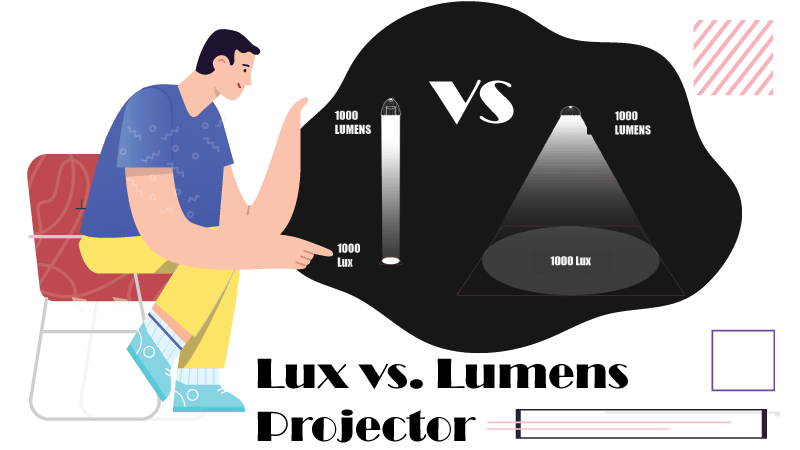
Sometimes, selecting the projector with the right level of brightness that matches its intended purpose may overwhelm you, especially when you find the projectors’ specifications too complicated to comprehend. Perhaps you probably cannot tell which particular specification indicates the light output of the projector.
In such situations, it is either you figure out the necessary details about projector brightness yourself. Or you get help from someone with more knowledge about them. However you intend to do it, you must understand how the brightness of the projectors is measured. And also their units of measurement.
Otherwise, you may end up buying a projector not bright enough to use for your office presentations or any other purpose intended.
But not to worry, this article will help you avoid such troubles and guide you on projector brightness properly.
How to Measure Light Output in a Projector: Lux Vs. Lumens Vs. ANSI Lumens
Projector brightness or projector light output plays a role in determining the clarity of projected images.
However, the crucial question is, how do you measure projector brightness?
You measure them in lux, lumen, and(/or) ANSI lumen. These units of measurements are all related to the brightness of projectors. While they share a few similarities, they also vary in some ways.
Let’s go further to the explanations of each of the units.
Lux: What is Lux?
Lux refers to brightness over a surface area or one (1) lumen per the area. In photometry, lux measures the intensity (as the human eye’s perception) of light through a surface.
Hold up. Were you slightly lost thereby the word “photometry“?
Fantastic if you did not. If you did, here is what it means. Photometry is the science of the measurement of light in terms of how the human eye perceives brightness.
A further explanation of lux is that it is the International System of unit (SI unit) of measurement of illuminance (the total luminous flux incident on a unit surface area).
Therefore, 1 lux translates to 1 luminous flux per square meter; 1 lux=1lm/m2
Lumens: What Are Lumens?
The total amount of visible light the source radiates refers to as Lumens. It is the perceived power of the light-emitting from its source. Lumens are also the SI unit for luminous flux.
For instance, the total luminous flux is one (1) lumen is when one (1) candela of the intensity of a light source radiates over an angle of 1 steradian.
Hence, 1 lumen(lm)=1 candela(cd) / 1 steradian(sr).
ANSI Lumens: What Are ANSI Lumens?
Since the introduction of ANSI lumens, it determines a more accurate unit of measuring projector brightness. You would see older projectors with only lumen measurements that are often inaccurate. However, most new projectors specify ANSI lumens, which has become the standard to measure lumens since the American National Standards Institute (ANSI) established it.
So, what makes ANSI lumens a more accurate measuring unit?
Let’s find out.
The ANSI lumen measurements go through meticulous methods involving more variables to ensure accuracy. Although it is a complex process that involves several components, including measuring white contrast fields at particular spots on the screen you are projecting on. For the total projected area, it accounts for the average and the multiplication of the measurements.
Are the processes complex?
Yes, they are. The processes highlighted above are only a few of them. Nonetheless, ANSI lumen measurements are more realistic and quantifiable.
On the other hand, lumens reflect inaccurate measurements that you should take with a pinch of salt. As explained earlier, lumen measures luminous flux, the perceived power of the light-emitting from its source. So, it is not only generic but also subjective. In other words, lumen measurement is unreliable.
That is why it is most advisable to buy projectors that list ANSI lumens on their specifications.
Comparing Lux and Lumens: What Wins?
Let’s now highlight the differences between lux and lumens and the similarities they share. Starting with what they have in common, lux and lumens are both SI units of projector brightness.
They both measure how bright a light source radiates but in two different contexts. While lux is the amount of light as it spreads over a specific area. Lumen is the quantity of light from its source, considering the sensitivity of the human.
When you measure lux and lumen from a fixed source, the lumen will remain the same as lux reduces with an increasing distance.
How Many Lumens Does Your Projector Need? Choosing the Right Projector
Now, you should have a better idea of measuring projector brightness, so how many lumens do you suggest your projector should have? The number of lumens will depend on the purpose of the projector. The more lumens it is, the brighter the projector is.
Therefore, to determine how many lumens your projector needs, consider these factors, display content, resolution, and ambient light. They all affect the number of lumens your projector will need.
Firstly, the display content. If you are to display a document with fewer graphics and more texts like an office presentation, it requires a projector with fewer lumens. Whereas, if the projector is dominantly for graphical content, then it needs more lumens.
As for the resolution of display devices, they are as crucial as lumens for the sake of clear images. The most common for home theaters are 4K and 1080p. Video game consoles use 1080p. Then, portable projectors Under $100 use 840 x 480 resolutions.
Lastly is ambient lighting. Where you will mount your projector will significantly impact the number of lumens required. Whether outdoor or indoors. The more ambient light the screen receives, the more lumens the projector needs (for enough brightness for an excellent viewing) and vice versa.
Consequently, a projector will require varied numbers of lumens based on their purpose of use.
Here is a more specific lumen requirement.
A business and portable projector will require at least 1500 lumens for your private and official use.
A projector used as a home theater will need not less than 2000 lumens to project tv shows and movies.
But when your projector is for playing games mostly, 2000 lumens is a sufficient minimum.
Conclusion: The Different Units of Brightness for Projectors -Lumens, Lux, and ANSI Lumens
As a user of projectors, you need to grasp the specifications of a projector. Knowing which ones are most crucial, given the various ways each of these specifications impacts the viewing experience.
This article has described critical concepts related to projector brightness, one of the specifications of projectors. Subsequently, it should guide you to understand how bright your projector needs to be. With your new knowledge of the units of the light output of projectors (lux, lumens, ANSI lumens), you can correctly select a projector that will give clearer views.
Finally, the comparison between the units of projector brightness, lux, and lumens shows that they differ. They also share something in common. That is their only similarity being that the two units measure the brightness a light source produces. Therefore, the lumens are significant in regards to light output when selecting the best projector.


This wonderful tech information, but doesn’t help at all.
Looking at two projectors and wondering how to compare:-
Projector A – Specifications: ‘x’ lux
Projector B – Specifications : ‘y’ lumens
Do we really expect a consumer, even a smart well educated one, to do a lot of math with complex variables before they can make realistic comparison of these two projectors sitting on the shelf.
Perhaps you should have reduced it all to an algebraic formula and recommended a suitable scientific calculator. Better still, an app, with 6-8 variables that the consumer can enter the details and have it spit out a comparison on a SINGLE SCALE.
I am none the wiser.
Sure, Lawrie. I am all set to make a calculate for you. Actually, it’s a good idea. Thanks.